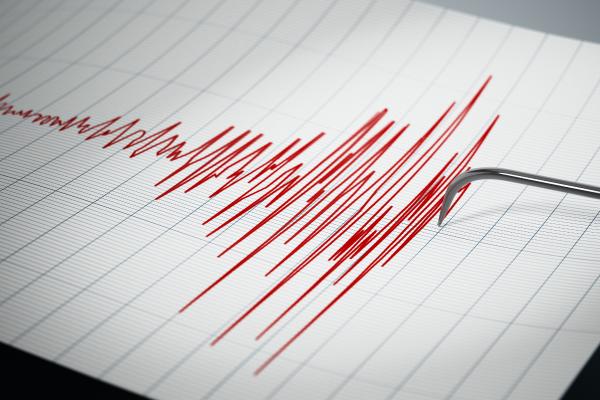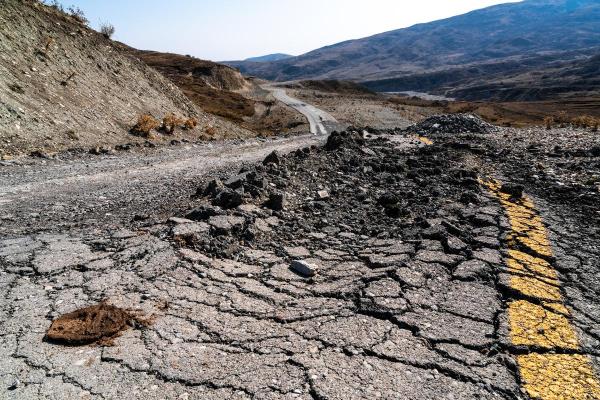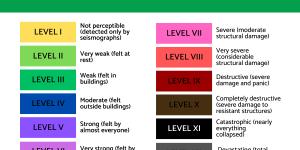What Is the Big One Earthquake?


The Big One is a term used to describe a potentially catastrophic earthquake expected to strike along major fault lines, such as the San Andreas Fault. Experts warn that when it happens, it could cause widespread destruction, aftershocks, and even tsunamis. But when might The Big One hit, and how dangerous could it be?
In this article by thedailyECO, we’ll explore what the Big One is, its potential risks, and essential safety tips to help you stay prepared.
What is the Big One?
"The Big One" refers to a hypothetical catastrophic earthquake expected to strike along the San Andreas Fault in the western United States. Seismologists use this term when discussing a future earthquake of magnitude 8 or greater that could cause unprecedented damage to major population centers like Los Angeles and San Francisco.
Experts warn about this potential mega-earthquake with increasing urgency. The San Andreas Fault marks the boundary between the Pacific and North American tectonic plates, making it one of the most active and dangerous fault zones in the world. Historical patterns suggest this fault system is "overdue" for significant movement, as it has been building strain for decades or centuries.
Scientific modeling shows that when the fault finally releases its accumulated energy, the resulting earthquake could last for minutes rather than seconds, creating widespread destruction. This concern is amplified by the dramatic increase in population density and infrastructure in high-risk zones since the last major events, meaning far more people and structures would be affected.
California has implemented extensive emergency plans and early warning systems to help mitigate the effects when this inevitable earthquake occurs, though exact timing cannot be predicted. Beyond immediate structural damage, secondary hazards like fires and potential tsunamis in some coastal areas remain significant concerns.
Understanding The Big One begins with grasping how earthquakes function at their most basic level.

When could the Big One happen?
The timing of The Big One remains one of the most challenging questions in seismology. Despite advances in earthquake science, there is simply no technology capable of determining the exact moment a major earthquake will strike.
What scientists do know is that the San Andreas Fault operates on a natural seismic cycle. The southern section of this fault is particularly concerning, as it has been accumulating pressure for an unusually long period.
Historically, major earthquakes along this region have occurred every 100 to 150 years. The last significant rupture on the southern San Andreas was the Fort Tejon earthquake of 1857, which was a massive 7.9 magnitude event. This means the area has gone more than 160 years without releasing substantial energy, significantly increasing the likelihood of The Big One occurring in the coming decades.
Current research suggests there is approximately a 60% chance of a magnitude 7.0 or greater earthquake striking Southern California within the next 30 years. Major population centers including Los Angeles, San Bernardino, and Palm Springs sit directly in the path of potential devastation.
The Pacific Northwest's Cascadia Subduction Zone presents another serious threat. This 700-mile fault extending from Northern California through Oregon and Washington to British Columbia is capable of producing even more powerful earthquakes, potentially reaching magnitude 9.0 or higher. Major cities at risk include Seattle, Portland, and Vancouver, with coastal communities facing both severe ground shaking and tsunami threats.
Confused about earthquake terminology? Explore the important distinctions between different types of seismic events in our detailed companion article.
Dangers of the Big One earthquake
The potential devastation from The Big One extends beyond the initial ground shaking. When this mega-earthquake strikes, it will trigger a cascade of destructive forces that could fundamentally alter the landscape and infrastructure of the affected regions.
The initial tremors would cause widespread structural failure across vulnerable buildings, particularly older structures not built to modern seismic codes. Despite California's strict earthquake regulations, many buildings remain insufficiently prepared for an earthquake of this magnitude. On the contrary, critical infrastructure such as bridges, highways, water systems, electrical grids, and gas lines could sustain catastrophic damage, potentially isolating communities for weeks or months.
Following the main shock, a series of secondary disasters would likely unfold:
- Aftershocks: could continue for months, hampering rescue efforts and causing additional damage to already weakened structures. These subsequent tremors, some potentially reaching significant magnitudes themselves, could trigger building collapses that initially survived the main shock.
- Widespread fires: would almost certainly erupt from broken gas lines and electrical shorts, reminiscent of the destruction following the 1906 San Francisco earthquake. Modern urban density provides even more fuel for potential firestorms. Not only that, but damaged water systems and blocked streets would severely impair firefighting capabilities.
- Soil liquefaction: presents another serious threat in areas built on loose, water-saturated soils, essentially turning solid ground temporarily into quicksand. This phenomenon could swallow buildings, rupture underground utilities, and render large areas uninhabitable.
- Basic services would likely fail: many areas could remain without these essential services for days or even weeks, complicating rescue efforts and survival for those affected.
- Tsunami waves: these could inundate shorelines within minutes, giving coastal residents precious little time to reach higher ground. Especially along the Pacific Northwest's Cascadia Subduction Zone.
- Landslides: would threaten hillside communities, particularly during rainy seasons when soil stability is already compromised. These mass movements of earth could bury homes and block critical evacuation routes.
- Economic impact: would be staggering, with estimates suggesting a major San Andreas rupture could cause $200+ billion in damage, while a full Cascadia event might approach $500 billion. Recovery would likely take decades in the hardest-hit areas, fundamentally reshaping regional development patterns and economies.
Ever wondered how seismologists quantify the difference between a minor tremor and a catastrophic quake? Explore the measurement system that helps us understand earthquake intensity.

How to prepare for a major earthquake
Preparing for a major earthquake like The Big One requires both immediate safety knowledge and long-term planning. Taking these steps now could make the critical difference when disaster strikes.
Here are some essential safety measures:
- Secure your home environment: anchor tall furniture, water heaters, and heavy appliances to wall studs. Install latches on cabinets containing breakables or hazardous materials. Secure heavy items on lower shelves and move beds away from windows.
- Drop, Cover, and Hold On: at the first sign of shaking, drop to your hands and knees, cover your head and neck (preferably under a sturdy table), and hold on until the shaking stops. Avoid doorways, windows, and exterior walls.
- Practice utility safety: learn how to shut off gas, water, and electricity. Keep a wrench near your gas meter. After a major earthquake, only shut off gas if you smell it or hear hissing.
- Establish meeting locations: designate two meeting places, one near your home and another outside your neighborhood, if evacuation is necessary. Map multiple ways to leave your home and neighborhood. Know the safest routes to higher ground if tsunami risk exists.
- Know your community resources: identify nearby emergency shelters, medical facilities, and community gathering points. Consider taking Community Emergency Response Team (CERT) training.
Finally, it is crucial to prepare an emergency kit for an earthquake like The Big One serves as your lifeline when normal systems collapse. In the aftermath of a major quake, utilities will fail, stores will close, and emergency services will be stretched beyond capacity, leaving you to rely entirely on your own resources.
Without access to running water, electricity, or functioning grocery stores, your supplies become the difference between comfort and crisis. Make sure to prepare a kit with:
- Water (one gallon per person per day for at least three days).
- Non-perishable food (minimum three-day supply).
- Hand-crank or battery-powered radio.
- Flashlights and extra batteries.
- First aid supplies.
- Prescription medications.
- Cash in small denominations.
- Sturdy shoes and warm clothing.
- Portable phone chargers.
- Copies of important documents in waterproof container.
While preparing for The Big One is crucial, understanding the awesome power of past seismic giants puts today's concerns in historical context. Discover the most powerful tremors humanity has ever recorded.

If you want to read similar articles to What Is the Big One Earthquake?, we recommend you visit our Facts about nature category.
- Mayen, J. (December 5, 2024). This is the date the Big One, a mega-earthquake on the San Andreas Fault, will occur. Money in Images. Available at: https://www.dineroenimagen.com/actualidad/en-esta-fecha-ocurrira-big-one-megaterremoto-por-falla-san-andres
- Velázquez Valdez, M. (September 4, 2024). San Andreas Fault: When will the next “Big One” or major earthquake occur and which cities will be affected? TV Azteca Specials. Available at: https://www.tvazteca.com/estados-unidos/falla-de-san-andres-cuando-sera-el-big-one-que-ciudades-estados-unidos-afectara-mvv
- What is the 'Big One' and why the tremors in California raise fears of an unprecedented earthquake. (December 20, 2022) Univision. Available at: https://www.univision.com/noticias/fenomenos-naturales/big-one-que-es-temblores-terremoto-california
- DeLaire, M. (July 18, 2024) When will the 'Big One' earthquake hit? Scientists weigh in. CTVNews. Available at: https://www.ctvnews.ca/climate-and-environment/article/when-will-the-big-one-earthquake-hit-scientists-weigh-in/
- Khalilm, Sh. and Drury, F. (August 9, 2024) Does Japan's megaquake alert mean the 'big one' is coming? BBCNews. Available at: https://www.bbc.com/news/articles/cx2en927054o
- Bush, E. (August 17, 2024) Earthquake scientists are learning warning signs of the 'big one.' When should they tell the public? NBC News. Available at: https://www.nbcnews.com/science/environment/earthquake-scientists-warning-signs-big-one-rcna161467
- Yeung, J., Montgomery, H., & Katsura, N. (August 12, 2024). Japan is bracing for a once-in-a-century earthquake. Does it need to? CNN. Available at: https://edition.cnn.com/2024/08/12/asia/japan-nankai-trough-earthquake-intl-hnk/index.html








